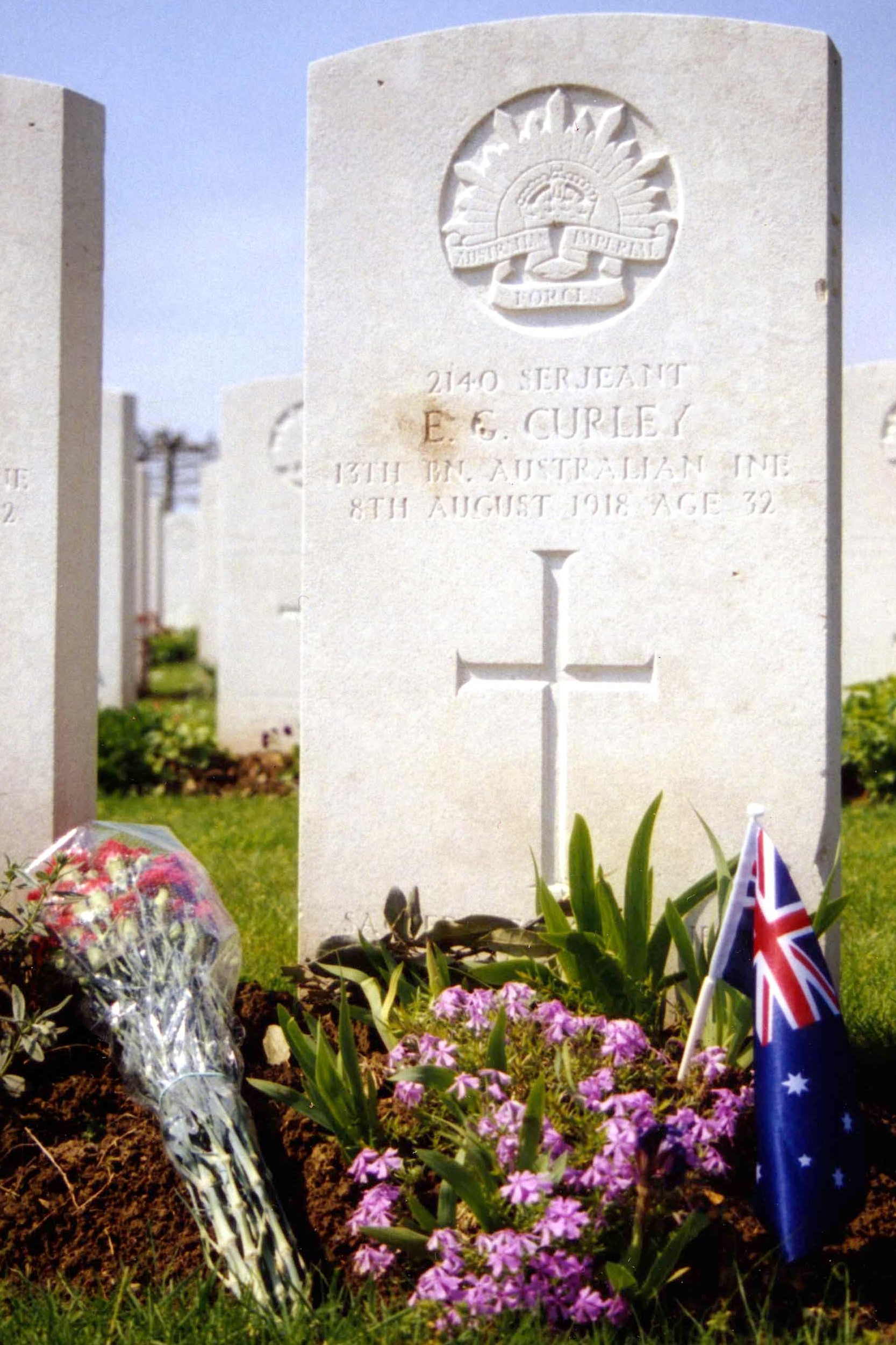For July 2020 we are looking at service of 2140 Sergeant Edward Grey Curley of the 13th Australian Infantry Battalion, First Australian Imperial Force.

Military Medals
Life Before Enlistment
Edward Grey Curley was born in 1886 to Edward and Ellen Curley in Walgett North-Western NSW, the family moved to Newcastle in 1890 when Edward was four years old. Edward was educated at Newcastle South Public School. After leaving school he found employment at the Government Rail Yards where he trained as a steel bridge mechanic.
In 1908 Edward married Ada and they lived in Hunter Street, Merewether, Newcastle. Ada and Edward had one son, Aubrey. A very keen sportsmen and rugby union player, he was a member of the team that won the Rugby 8s competition in 1910. Edward was one of the founding members of the Cook’s Hill Life Saving and Surf Club that was founded on the 11th of April 1911.
Military Service
On the 11th of May 1915, at age 29 Edward Grey Curley enlisted at Newcastle into the Australian Imperial Force, posted to 13th Australian Infantry Battalion (6th Reinforcements). On the 14th June 1915, he embarks at Sydney on Her Majesty's Australian Transport Ship (HMAT) Wandilla . PTE Curley lands at Gallipoli on 2nd August; however, he is evacuated on the 22nd of August with sickness (enteritis) to the Island of Lemnos in Greece and he rejoined the unit on 18th September.
 On the night of 18th December the battalion withdrew from Gallipoli Peninsula to Lemnos. After the withdrawal from Gallipoli, the battalion returned to Egypt. In June 1916, the 13th sailed for France and the Western Front. In June 1916 Edward was appointed to Lance Corporal and shortly after was made up to temporary Corporal, for which he was made substantive in August 1916. Corporal Curley was wounded in action (left hand) in the Pozières area, northern France on 10th August 1916 and evacuated to England. After recovering from his wounds, Curley goes Absent Without Leave (AWOL) for 23 days. He was charged and received 68 days forfeiture of pay. On 3rd May 1917, he rejoined his battalion training at Ribemont, northern France.
On the night of 18th December the battalion withdrew from Gallipoli Peninsula to Lemnos. After the withdrawal from Gallipoli, the battalion returned to Egypt. In June 1916, the 13th sailed for France and the Western Front. In June 1916 Edward was appointed to Lance Corporal and shortly after was made up to temporary Corporal, for which he was made substantive in August 1916. Corporal Curley was wounded in action (left hand) in the Pozières area, northern France on 10th August 1916 and evacuated to England. After recovering from his wounds, Curley goes Absent Without Leave (AWOL) for 23 days. He was charged and received 68 days forfeiture of pay. On 3rd May 1917, he rejoined his battalion training at Ribemont, northern France.
His charge did not affect his performance or leadership as he was promoted to temporary Sergeant on 4th July 1917. On the 24th September 1917, he was wounded in action (2nd occasion) in the Ypres (Ieper) area, Belgium and was evacuated to the United States Hospital at Rouen. He returned to the battalion in Belgium on 24th October 1917.
On the 9th of July 1918 his Commanding Officer, LTCOL Marks recommends Sergeant Curley for an award because of the following action:
'On 4th July 1918, during the operation against VAIRE WOOD, East of Corbie, Corporal Curley was in-charge of a section on the first wave of the advance. Shortly after leaving the jumping off line his Platoon Commander and Sergeant became casualties. Curley then took charge of the Platoon and in a most gallant and capable manner led it to its objective. He ably superintended the consolidation and soon after, when subjected to intense shell fire, he set a most cheerful and inspiring example to the men under his command.'

Unfortunately, it appears that the award recommendation was unsuccessful.
On the 8th of August 1918, Sergeant Edward Grey Curley was killed in action at aged 32 at Morcourt, during the Third Battle of Amiens. He was buried close to where he was killed; his body was later moved to the Heath Cemetery, Harbonnières, northern France, where he lies to this day.
A Leader on the Rugby Field
Edward Curley also showed strong leadership on the sporting field, he captained the 13th Battalion Rugby Union team for three years. During this time the team was undefeated. The team won the 4th Infantry Brigade Rugby Championship ‘Silver Cup’ in July 18, defeating the 15th Battalion Team for the trophy.









